SUMMARY
This is AI generated summarization, which may have errors. For context, always refer to the full article.
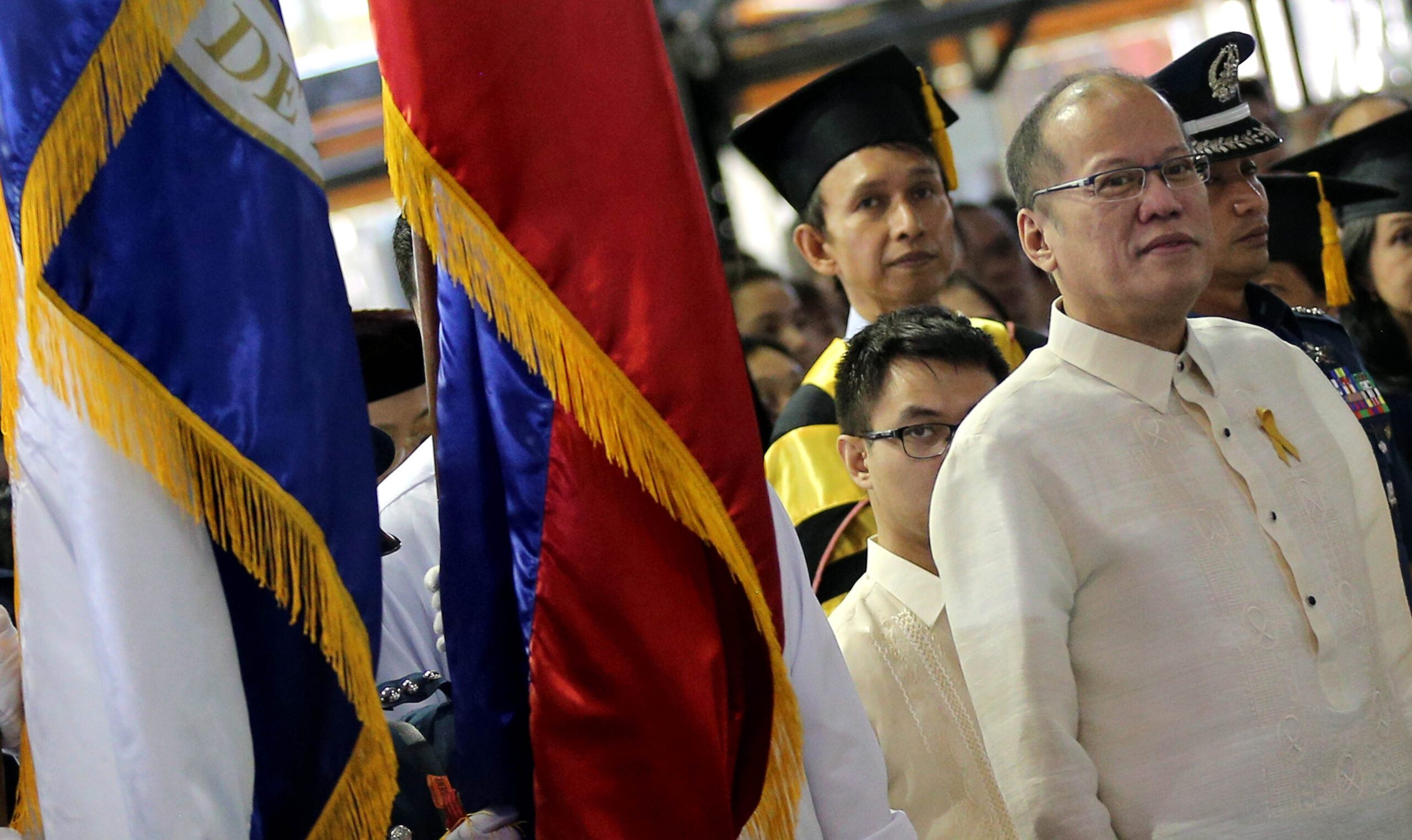
MANILA, Philippines – President Benigno “Noynoy” Aquino III is about to conclude his 6-year term, during which time Filipinos saw how he performed.
A review of the President’s overall performance and trust ratings shows how these gradually slumped as he neared the end of his term.
Yet his lows are not the worst, especially when compared to the series of preceding presidential declines in history.
‘Honeymoon’ stage
According to polling firm Social Weather Stations (SWS), in the early months of his term, Aquino had a normal honeymoon with the public as he had his very first net satisfaction rating of 60% in September 2010. That rating increased 4 percentage points in November of the same year.
This is no dfiferent from the net satisfaction ratings of previous presidents like Corazon Aquino who started with 53% in March 1986, and later surged to 72% in October; Fidel Ramos who started with 66% in September 1992 and increased to 69% in July 1993; Joseph Estrada, who rose from 60% in September 1998 to 67% in March 1999.
Aquino’s early scores definitely fared better than former president Gloria Macapagal Arroyo who started with 24% in March 2001 and moved up slightly to 30% in March 2004.
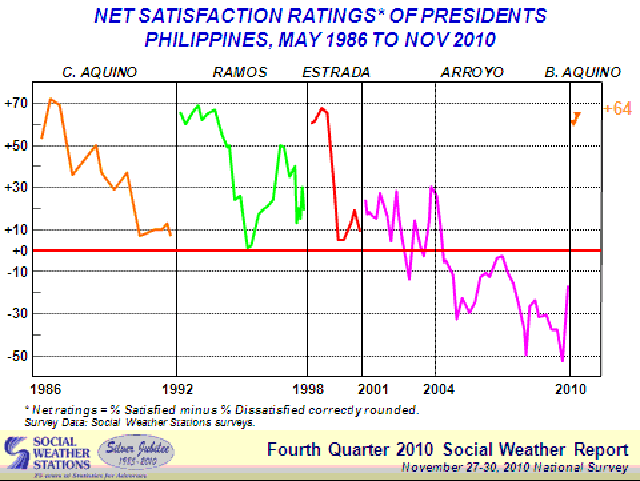
From Social Weather Stations (SWS)
Likewise, Aquino had the highest trust rating ever recorded in Pulse Asia’s trust surveys since 1999 with a staggering 85% as he began his 6-year term in June 2010.
According to the World Economic Forum (WEF), the country’s economic gain of 33 places since 2010 is the largest among all countries studied.
The President also noted that since the start of his leadership in 2010, the country has recorded an average goss domestic product (GDP) growth of 6.2%, the fastest average growth period in 40 years.
Shaken, not stirred
In the succeeding years, the trust dipped to more realistic levels, but without much difference. The trust ratings in the first quarter of the succeeding years were 75% in 2011, 69% in 2012, 72% in 2013, and 69% in 2014.
In 2012, the Philippines recorded one of its strongest years for economic growth, surpassing all expectations in growth trends. Likewise, the first quarter GDP of 2013, was recorded at 7.8% which further raised the bar among different nations.
Economic growth under the Aquino administration was one of the highlights of his presidency. But there were other main issues that caused a slight tug in the perception of his performance.
- Aquino vs Corona
In the first months of 2012, the whole country was focused on the impeachment trial of former Supreme Court chief justice Renato Corona since the President brought up the issue in a speech delivered at the Criminal Justice System summit in 2011. This was after the Corona court granted the Hacienda Luisita farmers the lands that had been denied them by the Aquino-Cojuangco clan.
Since then, Aquino’s ratings slowly dipped during Corona’s impeachment trial, despite his ratings gradually recovering in 2011. Complaints backed by the President’s allies in the House of Representatives triggered the impeachment. However, after Corona was convicted, Aquino’s ratings rose again.
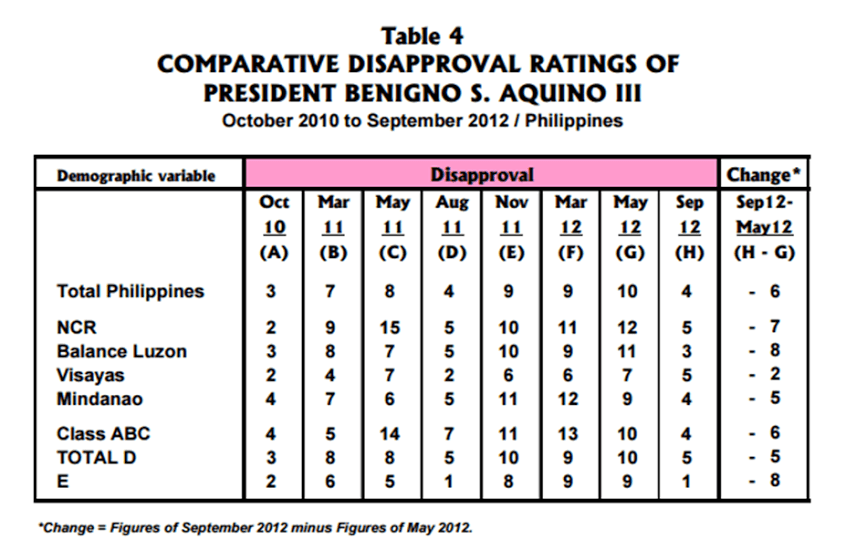
Comparative disapproval ratings noted by Pulse Asia show a huge jump in Aquino’s scores since the conflict between him and Corona.
- Pork barrel scam
Aquino’s ratings took a slight hit in the second half of 2013 when the pork barrel scam was exposed. This led to the detention of 3 senators and many other lawmakers under his administration due to plunder and graft cases. The event caused the President to abolish the graft-ridden Priority Development Assistance Fund (PDAF).

Comparative Pulse Asia trust ratings of Aquino from June to September 2013.
Pulse Asia noted that there were no significant changes between June and September 2013 in the overall ratings of Aquino. But in the different geographic areas and socio-economic classes, a few marked movements were evident.
Aquino received public criticism for the alleged “special treatment” he gave to suspected pork barrel scam mastermind Janet Lim Napoles who surrendered to him on August 28, 2013. Malacañang denied any special treatment and said the President agreed to Napoles’ request that she surrender to him out of security considerations, and to find out the truth behind the biggest corruption scandal to hit the country in recent years.
- The Zamboanga siege
In September 2013, the Zamboanga siege happened. Members of the Nur Misuari-led faction of the Moro National Liberation Front (MNLF) attempted to take over the city. The siege lasted for over a month before the government finally declared they had overwhelmed rebel forces.
The President himself was in Zamboanga for almost two weeks during the siege. He sent to Zamboanga City with Interior Secretary Manuel “Mar” Roxas, Fefense Secretary Voltaire Gazmin, and then Armed Forces chief General Emmanuel Bautista to help defuse the tension.
However, during the first week of the siege, Rappler reported that the chain of command wasn’t as clear-cut. (READ: Zamboanga siege: Aquino says Roxas deserves praise)
Likewise, political groups and other organizations denounced the Aquino government for not taking the condition of Zamboanga City residents into consideration. The total damage caused by the siege was estimated at US$73.2 million, according to the government.
Following these incidents, Aquino’s scores in the third quarter of 2013 were still positive. (READ: Aquino gets ‘very good’ grade in 2013 – SWS)
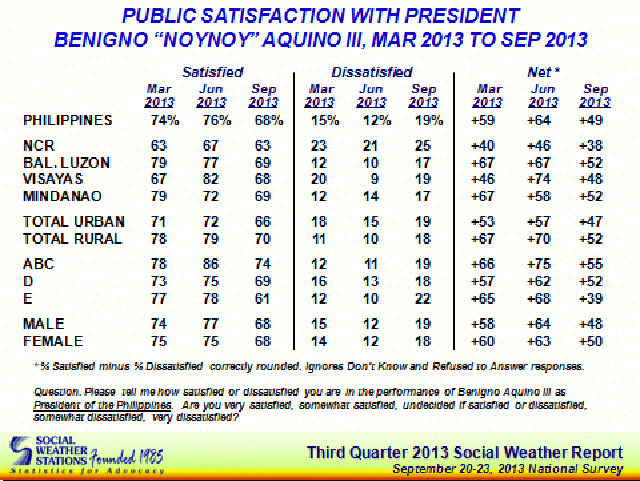
From SWS
- Yolanda hits the Philippines
Surprisingly, when another crisis, Super Typhoon Yolanda (Haiyan), hit the country in November 2013, Aquino still got a “very good” +54 net satisfaction rating in the SWS December 11 to 16 survey. This, despite criticism from some parties on how the administration handled the relief operations. Yolanda victims comprised 13% of Filipino families who responded in the curvey.
The SWS also said that its survey showed that Aquino’s net satisfaction rating would have been net +48 instead of net +49 without the Yolanda victims.
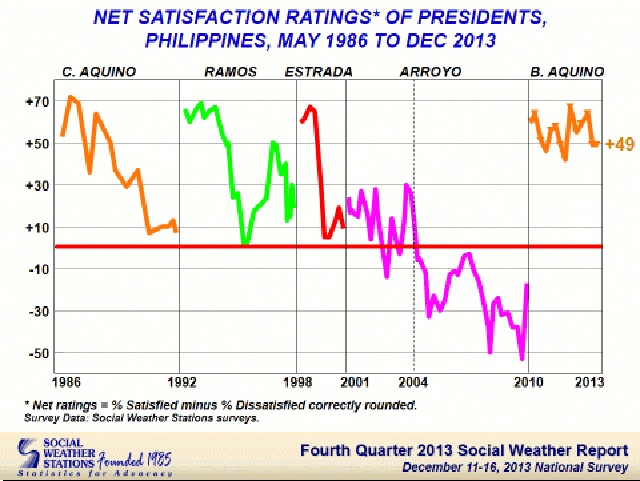
From SWS
Downhill
Surveys also noted the biggest drop in Aquino’s scores by 2014. The SWS June 2014 showed a 20-point drop, from +45 in March 2014 to +25 in June 2014. This was the first time that the administration received a “moderate” net satisfaction rating.
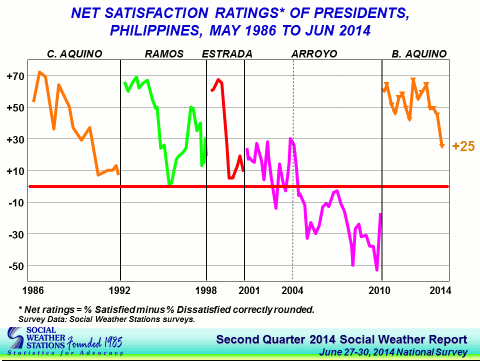
From SWS
- The controversial DAP
During this period, Aquino faced impeachment threats following the Supreme Court ruling that said the controversial Disbursement Acceleration Program (DAP) was unconstitutional.
The DAP was used as a reform intervention to speed up public spending and boost economic growth. This gave Aquino and the executive branch power over public funds.
On July 4, 2014, the Department of Budget and Management released a statement in response to a report claiming that P352.7 billion was made available for the disposal of the executive exclusively for DAP projects.
Furthermore, a total of P136.75 billion – P65.59 billion from the 2011 budget and P71.16 billion from the 2012 budget – was made available for projects under DAP. It was also noted that the total amount used from the fund was actually P114.58 billion, according to the Philippine Center for Investigative Journalism.
In a televised speech on July 14, 2014, Aquino responded to the Court’s ruling and defended the now defunct DAP saying: “DAP is good. Our intentions, our processes, and the results were correct. Bosses, I promise you: I will not allow your suffering to be prolonged – especially if we could do what we can as early as now.”
In his speech, he also attacked the SC, questioning how it arrived at such a controversial decision.
Nonetheless, the issue made a dent on Aquino’s popularity. In a Pulse Asia survey, Aquino’s approval rating dropped to 56% on June 14, from a high of 70% on March 15, 2014.

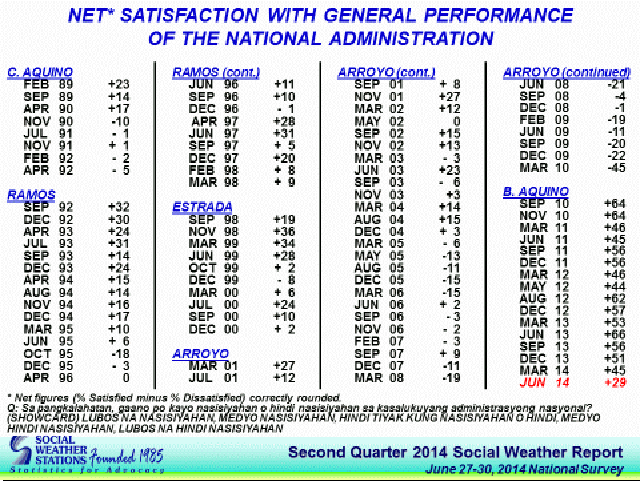
Aquino encounters a huge slump in SWS‘ June 2014 survey
- A history of declines
Aquino seemed to be following a similar trend of decline in presidential ratings experienced by his predecessors.
His mother, Cory Aquino, also plummeted to a single-digit 7% in November 1990 (a year after the December 1989 coup, along with the other serious coup attempts) and failed to recover.
President Fidel Ramos peaked at 69% in July 1993, but fell to a mere 1% in October 1995, when the country suffered a rice crisis.
Before Estrada was ousted from office in 2001, he plummeted to a 5% net satisfaction rating in the December 1999 and March 2000 surveys, according to SWS. This can be traced to the former president’s alleged involvement in the so-called “jueteng-gate” scandal.
Gloria Macapagal-Arroyo served as president for a total of 9 years – from 2001 to 2004 to fill in the unserved term of her ousted predecessor, and following her victory in the 2004 presidential race, from 2004 to 2010. She started with a +24 net satisfaction rating but ended with a -53 net rating near the end of her term, due to allegations of corruption and poll fraud.
- Biggest downfall: Mamasapano
Aquino faced the lowest trust and approval ratings in his term – a staggering +11 net satisfaction rating in March amid outrage over the Mamasapano incident. (READ: The emotional journey of Benigno Aquino III)
One of the biggest factors that caused public outrage was the President’s absence at the arrival honors for the remains of 42 of the 44 fallen policemen at the Villamor Airbase on January 29, 2015.
Many Filipino netizens slammed how Aquino handled the Mamasapano incident, and how he seemed to have washed his hands of the botched operation, based on his public explanation.

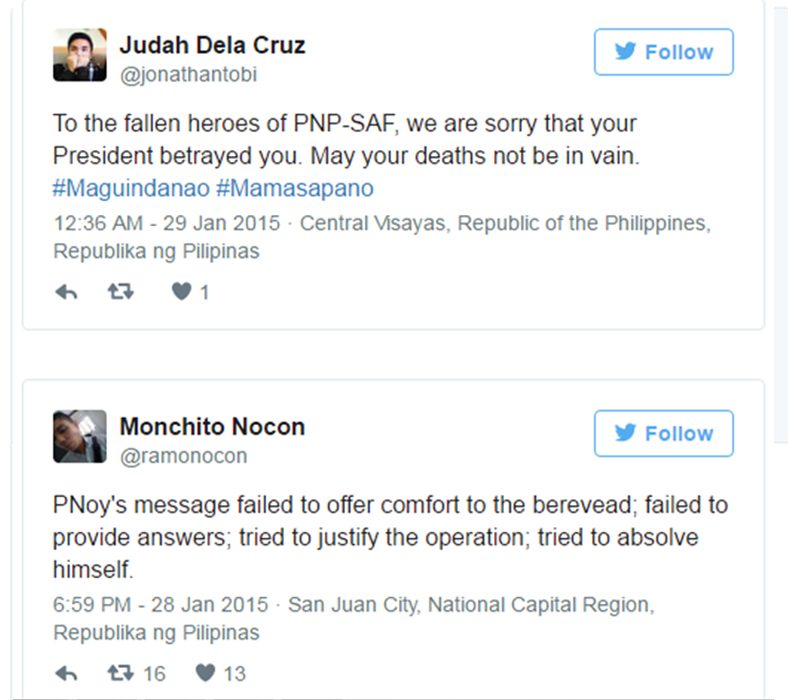
Netizens blast Aquino’s Mamasapano speech
A few months before Aquino’s term concludes, he gets the highest satisfaction ratings from the poorest Class E and the respondents from rural areas. The Visayas accounted for his highest satisfaction rating, based on geographical location, as of April 2016. However, Aquino’s satisfaction ratings have dropped in the NCR region, Luzon, and Classes ABC.
However, compared with the satisfaction ratings of past presidents since 1986, Aquino undoubtedly fared better, with a +27 net satistication rating as he ends his term. (READ: Aquino’s firsts)
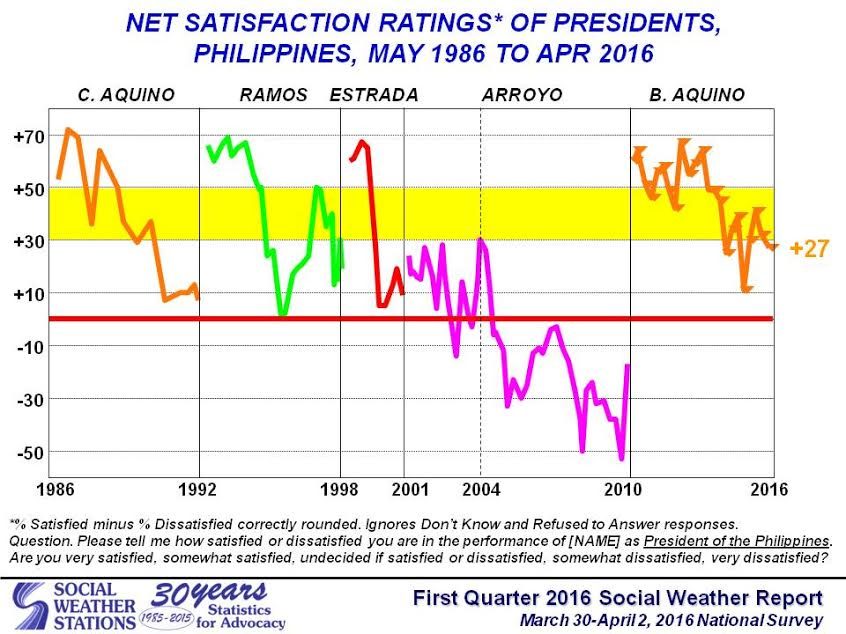
From SWS
Meanwhile, Pulse Asia notes that Aquino still recorded gains in his trust ratings during the period February to March 2016.

The surveys have shown that the satisfaction and trust in the performance of Philippine leaders tend to dip over time. But in a span of 6 years, Filipinos, in general, have looked kindly upon Aquino’s presidency.
This year, Davao City Mayor Rodrigo Duterte gained millions of supporters to take the highest office in the country. How long will it take before he follows the historical declines of his predecessors? – Rappler.com
Mary Gleefer Jalea is a Rappler intern.
Add a comment
How does this make you feel?
There are no comments yet. Add your comment to start the conversation.